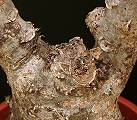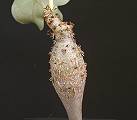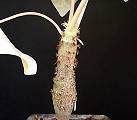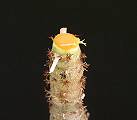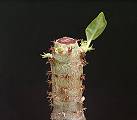|
Jatropha podagrica Hooker |
|
|
Fotos |
1 Ast mit Knospen 2
Caudex 3 Junges Blatt 4 Sämlinge 5 Blütenstand 6 Männliches Cyathium 7 Weibliches
Cyathium 8
Frucht |
|
Photos |
1 Branch with buds
2 Caudex 3
Young leaf 4 Seedlings 5
Inflorescence 6 Male cyathium
7 Female cyathium 8 Fruit |
|
Erstbeschreibung |
Hooker 1848, CBM 74: t. 4376 |
|
Initial description |
|
|
Heimat |
Mittelamerika |
|
Habitat |
Certral |
|
Wuchsform |
|
|
Growth
form |
|
|
Blüten |
|
|
Flowers |
|
|
Kalender |
|
|
Calendar |
|
|
Kultivierung |
|
|
Cultivation |
|
|
Min. Temperatur |
12 °C |
|
Min. temperature |
54 °F |
|
Schädlinge &
Krankheiten |
(keine beobachtet) |
|
Pests and diseases |
(not any observed) |
|
Ähnliche Arten |
|
|
Similar species |
|
|
Weitere Informationen |
Während junge Sämlinge meist
eine winterliche Ruhepause einhalten, neigen ältere Pflanzen dazu, auch im
Winter zu wachsen und zu blühen. Das kann jedoch von Jahr zu Jahr variieren.
Die Pflanzen sollten nicht zu einer Ruhezeit gezwungen werden, wenn sie weiter wachsen wollen. |
|
Additional
information |
While
seedlings mostly fall dormant during winter, older plants tend to grow and
flower also in this season. However, this can vary from year to year. The
plants should not be forced to fall dormant if they like to grow furthermore. |
|
Die Beschneidung The pruning |
|
|
Weitere Informationen |
Foto A: Alle
Pflanzen im kommerziellen Handel sind beschnitten. Der erste, zentrale Ast
wurde entfernt. Je nach der einzelnen Pflanze erinnert nur ein kurzer Stumpf
wie hier oder nur eine kaum sichtbare Narbe an die Enthauptung. Foto B: Manchmal
gibt die Natur einen Hinweis. Bei diesem Sämling war der zentrale Ast auf
Grund einer Krankheit abgestorben. Nach diesem Vorfall verzweigt die Pflanze
nun und der Caudex schwillt an. Foto C: Ein
Sämling, der noch einen zentralen Ast hat, neigt wenig zur Ausbildung des
Caudex oder zur Verzweigung. Foto D: Machen wir
es nun wie die professionellen Gärtner und beschneiden den Sämling. Kopf ab! Man braucht nur
die obersten 3 mm abzuschneiden. Foto E: Nur 3 Wochen später sprießen bereits mehrere Äste. Bald wird diese Pflanze aussehen, wie die in Foto C. Später kann man die Pflanze
tiefer in den Topf setzen, so, dass ihr schmaler Hals im Boden versteckt
wird. |
|
Additional
information |
Foto A: All plants of Jatropha podagrica in commercial trade are pruned and lack
their intital, central branch. Depending on the certain plant a short stump
like this or only a hardly visible scare reminds on the former decapitition. Foto B: Sometimes nature gives a clue. This is a seedling that losts its
central branch by some disease, and after this event the plant branched and
developed a pretty swollen caudex. Foto C: A seedling that still bears a central branch doesn’t like developing
a caudex. Foto D: Let’s do like the professional growers. Let’s prune that seedling.
Head off! One
only needs to cut away the upper 3 mm. Foto E: Only 3 weeks later several branches are sprouting. The plant will
soon look like the one in photo C. Later
one can place the plant deeper in the pot so that its narrow neck becomes
hidden in the soil. |
Fanden Sie diese Seite ohne einen linken Rahmen, laden Sie bitte www.euphorbia.de
If you found this page without a left frame
please load www.euphorbia.de
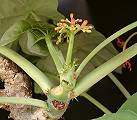
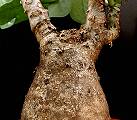
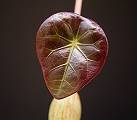
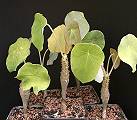
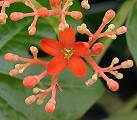
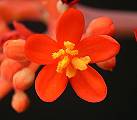
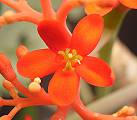
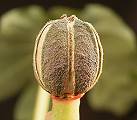
 2 m
2 m 




